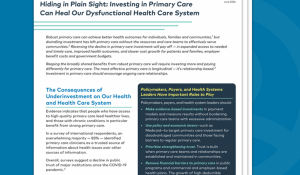You are looking at an archived version of our site. Please visit thepcc.org for a fresh, new experience!
You are here: Array » Mixed Results For Obam ...
Mixed Results For Obamacare Tests In Primary-Care Innovation
Medical homes are a simple, compelling idea: Give primary-care doctors resources to reduce preventable medical crises for diabetics, asthmatics and others with chronic illness — reducing hospital visits, improving lives and saving money.
But it’s not so easy in practice.
New reports show that two big experiments run by the health law’s innovation lab, known as the Center for Medicare & Medicaid Innovation, delivered mixed early results in enhancing primary care. The programs reduced expensive hospital visits in some cases but struggled to show net savings after accounting for their cost.
Consultants evaluated the first year’s results for the Comprehensive Primary Care Initiative, a four-year program in Colorado, New Jersey and several other states; and the Multi-Payer Advanced Primary Care Practice Demonstration, a three-year test in eight states including New York and Pennsylvania.
The CPC initiative cut costs by $168 per participating Medicare beneficiary, thanks largely to declines in hospital admissions and emergency visits, compared with results of practices not part of the initiative. Results were “more favorable than might be expected” in the test’s first year, said a report by Mathematica Policy Research.
But that wasn’t enough to cover the extra $240 per patient that HHS paid practices to hire extra nurses, improve electronic records, set up 24-hour call lines and make other adjustments. The goal was to identify high-risk patients, keep them on the right medicines and diets and steer them to lower-cost treatment.
“The numbers don’t take your breath away,” said Marci Nielsen, CEO of the Patient-Centered Primary Care Collaborative, a consortium of payers and caregivers. “But … the fact that the early results look as good as they do we take to be very good news.”

Recent News
August 16, 2024
August 12, 2024
July 16, 2024
May webinar highlights: “The Commercial Market: Alternative Payment Models for Primary Care” Nate Murray explains w… https://t.co/KX9Wi2w6oY —
2 years 5 months ago
@CMSinnovates’ primary care strategy is rooted in a 2021 @theNASEM’s report which called #primarycare “foundational… https://t.co/glbPxvCysg —
2 years 5 months ago
@CMSinnovates has a new #primarycare strategy, envisioning “ACO-based primary care model tests that may focus on pr… https://t.co/aJGF1z411l —
2 years 5 months ago
- Page 1
- ››
Secondary menu
Copyright © 2024 Primary Care Collaborative



